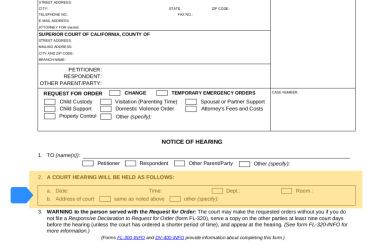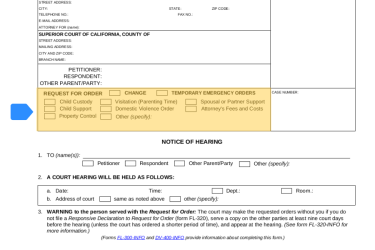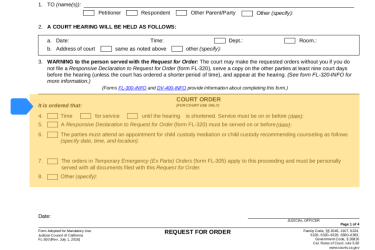What do these papers mean?
Request for Order (form FL-300)
If you received a Request for Order (form FL-300), it means the other person in your family law case is asking the judge to make a decision. The court sets a date to hear from both sides (a hearing) before it makes a decision.

Hearing date and time
The date, time, and location are on the first page.
What if I need more time or can't attend the hearing?
What the other person is asking the judge to decide
The things the other person is asking the judge to decide are checked on the first page. The details of what they want and why are on pages 2–4 and any attachments.
If "Change" is checked it means that there's already an order about this issue and the other person wants that changed.
If “Temporary emergency orders” is checked it means the other person asked the judge to decide something urgent before the hearing. If the judge agreed, item 7 at the bottom of page 1 will be checked and the orders will be attached or in a separate form, Temporary Emergency Orders (form FL-305).

Orders made before the hearing
Any orders that the court makes before the hearing will be listed here. This could be a temporary order that the other person requested (see above) or an order the judge made about what one or both people must do before the hearing.
For example, if the hearing is about child custody and visitation, the court may order you to attend mediation before the hearing.
Your options
Come to an agreement with the other side
If you can work with the other side (and there is no restraining order involved) you may be able to come to an agreement on your own without going to court.
Respond to the Request and attend the hearing
- If you disagree with what the other side is requesting or saying, you can respond to their request.
- If you agree with all of it or even part of the request, and want to let the judge know, you can also file your response and say that.
You do this by filling out, filing, and serving a court form (opens in a new tab) that tells the court if you agree or disagree and why. Then you must attend the hearing and tell the judge your side of the story.
There's generally no cost to respond, but if this is the first time you are filing papers in the case, there may be a fee. If you can’t afford the fee, you can ask for a fee waiver.
Choose to not respond
You don't have to respond to this request, but if you do not respond, the judge will decide without hearing from you.
Consider getting help
This website has information to walk you through the basic process. But, you may need more help or legal advice.
The court has a program where they offer free legal information about your case. Learn more about the court’s family law facilitator or self-help center.
Respond to a Request for Order
What's next
Once you decide if and how you're going to respond to the request, navigate to the step-by-step instructions for help with completing the task.
Keep in mind that you may have to act quickly. If you're going to respond, you must complete and serve your response to the other side 9 court days before the hearing.

